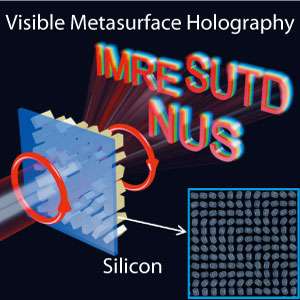Silicon holograms harness the full visible spectrum to bring holographic projections one step closer

We can't yet send holographic videos to Obi-Wan Kenobi on our droid, but A*STAR researchers have got us a little bit closer by creating holograms from an array of silicon structures that work throughout the visible spectrum.
Many recent advances in hologram technology use reflected light to form an image; however the hologram made by Dong Zhaogang and Joel Yang from the A*STAR Institute of Materials Research and Engineering uses transmitted light. This means the image is not muddled up with the light source.
The team demonstrated the hologram of three flat images at wavelengths ranging from blue (480 nanometers) to red (680 nanometers). The images appeared in planes 50 microns apart for red and higher spacings for shorter wavelengths.
"In principle, it can be tuned to any wavelength," says Yang.
Holograms can record three-dimensional images, which mean they can store large amounts of information in increasingly thin layers.
Recently, holograms that are mere hundredths of the thickness of a human hair have been made from metal deposited onto materials such as silicon. The holograms are created by nanoscale patterns of metal that generate electromagnetic waves that travel at the metal–silicon interface; a field called plasmonics.
Silicon holograms are slightly thicker than the metal-based ones, but have the advantage of being broadband. Plasmonic holograms only operate in the red wavelengths because they undergo strong absorption at blue wavelengths.
A disadvantage of the silicon holograms is their poor efficiency at only three per cent; however Dong estimates this could easily be tripled.
"The losses can be lowered by optimizing the growth method to grow polycrystalline silicon instead of amorphous silicon," he says.
The hologram is an array of tiny silicon skyscrapers, 370 nanometers tall with footprints 190 nanometers by 100 nanometers. Unlike a city grid, however, the tiny towers are not laid out in neat squares but at varying angles.
The hologram operates with circularly polarized light, and the information is encoded on to the light beam by the varied angles of the skyscrapers. These alter the phase of the transmitted light through the 'Pancharatnam–Berry effect'.
"What's interesting about this hologram is that it controls only the phase of the light by varying the orientation of the silicon nanostructures. The amplitude is the same everywhere; in principle you can get a lot of light transmitted," says Yang.
More information: Kun Huang et al. Silicon multi-meta-holograms for the broadband visible light, Laser & Photonics Reviews (2016). DOI: 10.1002/lpor.201500314





















